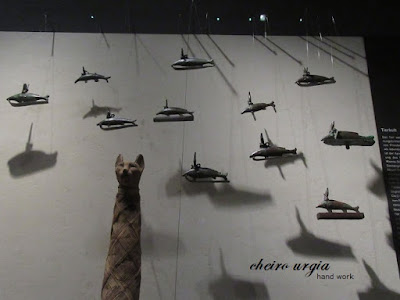Having heard lots of praise for the State Museum of Egyptian Art, I thought I'd give it a try and explore the life of ancient Egyptians. What I expected was a little stroll through what is on display and then maybe another stroll through the city later in the day. What I got was a wonderful collection of ancient art that was created through the centuries, with lots of additional information in the "subtitles" as well as in various interactive elements.
Atop of all, I was surprised by helpful staff who invisibly guards the exhibition and is yet always there for additional explanation. Extra plus: they seem to have an eye for visitors who seem to need a little help, and are obviously trained in approaching them with suggestions e.g. making the visit special to families with children, too, by pointing out things that might be interesting to the little guests.
Turns out the only guy I found a little weird was the one guarding the museum from a huge pillar in front of the entrance :)
One might not be aware of it when visiting a museum, but yes, at one point, all art has been contemporary. Display of Egyptian art from different epochs...
... Such as 5000 years old frogs and turtles...
... Stone tablets with hieroglyphics...
... Colourful sarcophagi...
... And the obelisk in the atrium that is center of this first part of the exhibition.
In contrast to the artistic overview, the rest of the museum is divided into different thematic areas which describe the life in ancient Egypt focusing on politics, religion, crafts, scripture... Each of the rooms will have a bilingual introduction about its contents and extensive explanations of the objects on display. Additionally, there are several touchscreens on which one may discover the secrets of ancient Egypt.
In general, I'd say most of the animal figures look quite realistic. This duck - not so much.
A great piece on death and afterlife, explaining rituals, typical graves and grave goods, visions of "the other side", and a couple more sarcophagi and masks.
Grave goods in form of food and sculptures of servants and livestock which should ensure a comfortable afterlife.
Coffin lid of Sadtjehuti
Various ushabti figurines
Book of the Dead, a collection of illustrated prayers and spells that should guide the deceased on the journey through the afterlife with descriptions of scenes they might encounter. The interactive screen under the exhibit itself can be moved from one chapter to another and enables reading by fading in a translation next to the original text on the display.
Does a judgment of ones good and bad deeds that ends either with paradise or eternal fire sound familiar?
And where could the mummies be? According to traditional belief, a body is to remain unseen until it is transformed on "the other side". Therefore, Egyptian paintings will picture a coffin rather than the dead body itself, or show the deceased later on in the process of transition, when it is already wearing precious linen and a golden mask. With that in mind, the depiction of a dead body would mean the person has failed to enter paradise and remains doomed forever.
Beautiful beadweaving
Lots of interesting things to see in the religious section, too. Next to numerous animal-gods and divine animals, another interactive screen allows exploring each god by origin, symbols and function. Again, I was surprised to see how much of Christianity seems to be actually copypasted from other ancient cultures, which becomes most obvious in statues of the mother goddess Isis holding a son in her arms.
Off to domestic art - colourful fabric, pottery and more give insight into how a home looked like in ancient times.
Hieroglyphics
However, at some point, the loudspeakers kindly asked the remaining visitors to go to the exit as the museum was about to close. Turns out my Egyptian journey made me completely forget the time to an extent that meant I'd have to rush past the remaining exhibits, trying to absorb as much as I could without properly studying what was on display.
A glimpse of Egyptian healthcare...
... the art of stonework...
... and some more pottery.
By the end of the museum tour, one can get to know the cultures that neighboured ancient Egypt, and sooner or later included Egyptian motifs and techniques. I certainly wish I had kept an eye on my watch and divided my time a little better.However, a golden sunset from the nearby terrace of the Technical University seemed to make up for what I missed in the catacombs. And somehow, despite all the work and the shock at the beginning, Munich began to feel like a beautiful city...
~ to be continued ~


























































































No comments:
Post a Comment